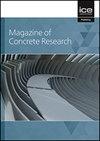Punching shear tests and design of UHTCC-enhanced RC slab-column joints with shear reinforcements
IF 1.6
4区 工程技术
Q3 CONSTRUCTION & BUILDING TECHNOLOGY
引用次数: 0
Abstract
Reinforced concrete (RC) flat slab structure may suffer progressive collapse, which is usually caused by the punching shear failure of slab-column joints. Existing research has shown that the utilization of shear reinforcements or ultra-high toughness cementitious composite (UHTCC) in slab-column joints is efficient in improving their punching shear performance. In this study, shear reinforcement was introduced into UHTCC-enhanced RC slab-column joints. Specimens of UHTCC-enhanced slab-column joints considering the effect of shear reinforcements were tested. The cracking development process, bearing capacity, and ductility were analyzed. Yield line theory and critical shear crack theory were adopted to predict flexural and punching shear capacities, respectively. Finally, the failure patterns of the specimens were discriminated by comparing the predicted punching shear and flexural capacities, taking the ductile coefficient into account. The theoretical results combined with test results show the effect of shear reinforcement on the behavior of UHTCC-enhanced joints. Significant improvement in the bearing capacity and ductility of joints is achieved by applying shear reinforcement. The failure pattern of a joint varies from premature punching shear failure to flexural-triggered punching shear failure with the application of UHTCC, and this transform is more pronounced with shear reinforcement applied into the UHTCC-enhanced joint.带剪力加固的 UHTCC 增强型钢筋混凝土板柱连接的冲剪试验和设计
钢筋混凝土(RC)平板结构可能会逐渐坍塌,这通常是由板柱连接处的冲剪破坏引起的。现有研究表明,在板柱接缝中使用抗剪钢筋或超高韧性水泥基复合材料(UHTCC)可有效改善其冲剪性能。在本研究中,UHTCC 增强型 RC 板柱连接中引入了剪力加固。对考虑了剪力加固效应的 UHTCC 增强板柱连接试件进行了测试。分析了裂缝发展过程、承载能力和延性。采用屈服线理论和临界剪切裂缝理论分别预测了抗弯和抗冲剪能力。最后,通过比较预测的冲剪承载力和抗弯承载力,并考虑延性系数,对试样的破坏模式进行了判别。理论结果与试验结果相结合,显示了剪力加固对 UHTCC 增强接头行为的影响。通过采用剪力加固,接头的承载能力和延展性得到了显著提高。使用 UHTCC 后,接头的破坏模式会从过早的冲剪破坏转变为挠曲触发的冲剪破坏,而在 UHTCC 增强接头中使用剪切加固后,这种转变更为明显。
本文章由计算机程序翻译,如有差异,请以英文原文为准。
求助全文
约1分钟内获得全文
求助全文
来源期刊

Magazine of Concrete Research
工程技术-材料科学:综合
CiteScore
4.60
自引率
11.10%
发文量
102
审稿时长
5 months
期刊介绍:
For concrete and other cementitious derivatives to be developed further, we need to understand the use of alternative hydraulically active materials used in combination with plain Portland Cement, sustainability and durability issues. Both fundamental and best practice issues need to be addressed.
Magazine of Concrete Research covers every aspect of concrete manufacture and behaviour from performance and evaluation of constituent materials to mix design, testing, durability, structural analysis and composite construction.
 求助内容:
求助内容: 应助结果提醒方式:
应助结果提醒方式:


